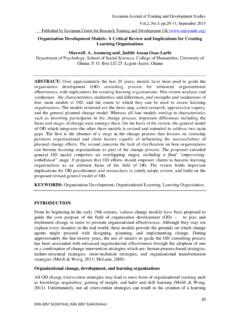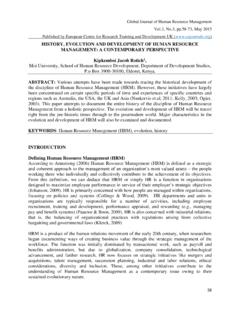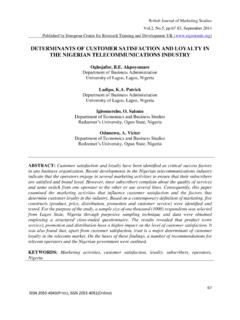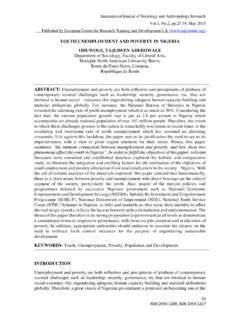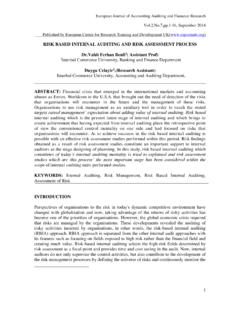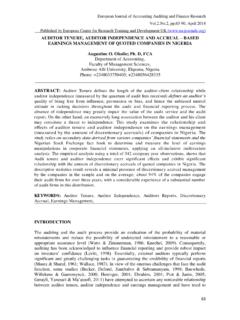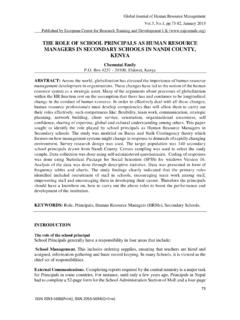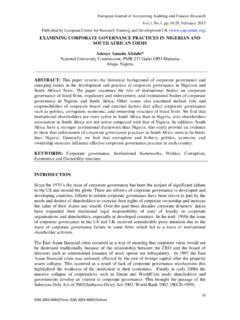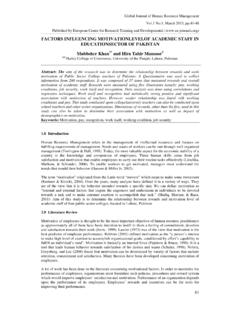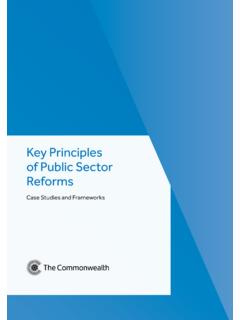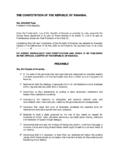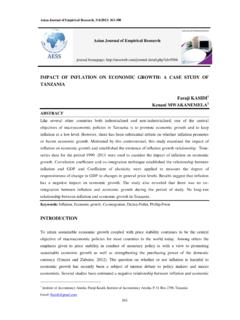Transcription of EFFECT OF CREDIT MANAGEMENT ON PERFORMANCE OF …
1 International Journal of Business and MANAGEMENT Review , , , May 2016 ___Published by European Centre for Research Training and development UK ( ) 1 ISSN: 2052-6393(Print), ISSN: 2052-6407(Online) EFFECT OF CREDIT MANAGEMENT ON PERFORMANCE OF COMMERCIAL BANKS in rwanda ( a case STUDY OF EQUITY BANK rwanda LTD) Alice Kagoyire and Dr. Jaya Shukla Jomo Kenyatta University of Agriculture and Technology, Kigali, rwanda . ABSTRACT: CREDIT MANAGEMENT is one of the most important activities in any company and cannot be overlooked by any economic enterprise engaged in CREDIT irrespective of its business nature.
2 Sound CREDIT MANAGEMENT is a prerequisite for a financial institution s stability and continuing profitability, while deteriorating CREDIT quality is the most frequent cause of poor financial PERFORMANCE and condition. As with any financial institution, the biggest risk in bank is lending money and not getting it back. The study sought to determine the EFFECT of CREDIT MANAGEMENT on the financial PERFORMANCE of commercial banks in rwanda . The study adopted a descriptive survey design. The target population of study consisted of 57 employees of Equity bank in CREDIT department.
3 Entire population was used as the sample giving a sample size of size of 57 employees. Purposive sampling technique was used in sampling where the entire population was included in the study. Primary data was collected using questionnaires which were administered to the respondents by the researcher. Descriptive and inferential statistics were used to analyze data. The study found that client appraisal, CREDIT risk control and collection policy had EFFECT on financial PERFORMANCE of Equity bank. The study established that there was strong relationship between financial PERFORMANCE of Equity bank and client appraisal, CREDIT risk control and collection policy.
4 The study established that client appraisal, CREDIT risk control and collection policy significantly influence financial PERFORMANCE of Equity bank. Collection policy was found to have a higher EFFECT on financial PERFORMANCE and that a stringent policy is more effective in debt recovery than a lenient policy. The study recommends that Equity bank should enhance their collection policy by adapting a more stringent policy to a lenient policy for effective debt recovery. ABSTRACT: CREDIT MANAGEMENT , Banks, Debt Recovery, Lending, Money, Financial PERFORMANCE , Risk Control, Client Appraisal INTRODUCTION CREDIT is one of the many factors that can be used by a firm to influence demand for its products.
5 According to Horne and Wachowicz (1998), firms can only benefit from CREDIT if the profitability generated from increased sales exceeds the added costs of receivables. Myers and Brealey (2003) define CREDIT as a process whereby possession of goods or services is allowed without spot payment upon a contractual agreement for later payment. Timely identification of potential CREDIT default is important as high default rates lead to decreased cash flows, lower liquidity levels and financial distress. In contrast, lower CREDIT exposure means an optimal debtors level with reduced chances of bad debts and therefore financial health.
6 According to Scheufler (2002), in today s business environment risk MANAGEMENT and improvement of cash flows are very challenging. International Journal of Business and MANAGEMENT Review , , , May 2016 ___Published by European Centre for Research Training and development UK ( ) 2 ISSN: 2052-6393(Print), ISSN: 2052-6407(Online) With the rise in bankruptcy rates, the probability of incurring losses has risen. Economic pressures and business practices are forcing organizations to slow payments while on the other hand resources for CREDIT MANAGEMENT are reduced despite the higher expectations.
7 Therefore it is a necessity for CREDIT professionals to search for opportunities to implement proven best practices. By upgrading your practices five common pitfalls can be avoided. Scheufler (2002) summarizes these pitfalls as failure to recognize potential frauds, underestimation of the contribution of current customers to bad debts, getting caught off guard by bankruptcies, failure to take full advantage of technology, and spending too much time and resources on CREDIT evaluations that are not related to reduction of CREDIT defaults.
8 CREDIT MANAGEMENT is one of the most important activities in any company and cannot be overlooked by any economic enterprise engaged in CREDIT irrespective of its business nature. It is the process to ensure that customers will pay for the products delivered or the services rendered. Myers and Brealey (2003) describe CREDIT MANAGEMENT as methods and strategies adopted by a firm to ensure that they maintain an optimal level of CREDIT and its effective MANAGEMENT . It is an aspect of financial MANAGEMENT involving CREDIT analysis, CREDIT rating, CREDIT classification and CREDIT reporting.
9 Nelson (2002) views CREDIT MANAGEMENT as simply the means by which an entity manages its CREDIT sales. It is a prerequisite for any entity dealing with CREDIT transactions since it is impossible to have a zero CREDIT or default risk. The higher the amount of accounts receivables and their age, the higher the finance costs incurred to maintain them. If these receivables are not collectible on time and urgent cash needs arise, a firm may result to borrowing and the opportunity cost is the interest expense paid.
10 Nzotta (2004) opined that CREDIT MANAGEMENT greatly influences the success or failure of commercial banks and other financial institutions. This is because the failure of deposit banks is influenced to a large extent by the quality of CREDIT decisions and thus the quality of the risky assets. He further notes that, CREDIT MANAGEMENT provides a leading indicator of the quality of deposit banks CREDIT portfolio. A key requirement for effective CREDIT MANAGEMENT is the ability to intelligently and efficiently manage customer CREDIT lines.
